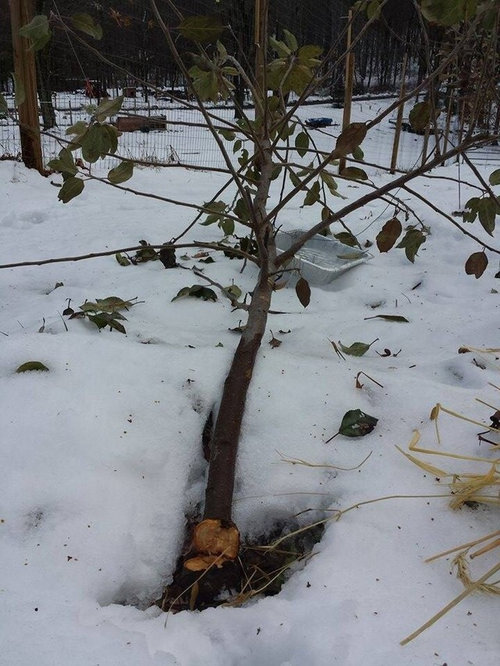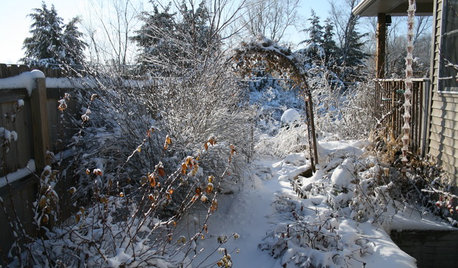Apple tree broke at the graft union
I just found out this morning that my Gala apple tree that I planted last year, broke at the graft union. What should I do? Is it possible to re-erect the tree and put stake right next to it? The tree is about 8 feet tall already so I probably need to prune first? I suspect this was caused by early snow -4 days ago- plus the wind plus the tree still have leaves. I have 7 other apple trees that I planted at the same time, are fine eventhough they also still have leaves. My other fruit trees (pear, cherry, peach dropped their leaves already). Is it normal for apple tree to drop the leaves late like this?

Comments (32)
JoppaRich
9 years agoI'd be surprised if pushing it back up and staking it works. Personally, I'd cut a bunch of scion wood from the top, and graft in the spring/late winter. You'll be set back a bit, but you've got a good rootbase, and it should grow quickly.
RedSun (Zone 6, NJ)
9 years agoThis is the worst you can have, green leaves with tons of snow.
Even if the tree can be saved by pushing back, it is a very weak tree.
Related Professionals
Windham Landscape Architects & Landscape Designers · Leawood Landscape Architects & Landscape Designers · Willowick Landscape Architects & Landscape Designers · Medford Landscape Contractors · Surprise Landscape Contractors · Allentown Landscape Contractors · Camp Verde Landscape Contractors · Dickinson Landscape Contractors · Kettering Landscape Contractors · Lexington Landscape Contractors · Red Oak Landscape Contractors · Roseville Landscape Contractors · Waltham Landscape Contractors · York Landscape Contractors · Merrifield Landscape Contractorsmurkwell
9 years agoI'm sorry to say that I think this tree is toast. Do you know what rootstock the Gala was on? Perhaps there is a partial incompatibility with Gala.
The tree looks awfully big for being planted last year. Perhaps it is on a seedling rootstock?
If it were mine, I'd probably let a sucker grow this spring and then graft a different variety (not Gala) to it. Then buy another Gala tree, or later topwork part of the tree with Gala.
alan haigh
9 years agoOn the bright side, it's a Gala.
Sorry, I know that was mean, but to me Gala is really the queen of bland even if it likes to fruit.
I think it is rare for a tree to break at the graft union unless there is some lack of compatibility. By now it should be as strong there as anywhere along the trunk. Trees tip over from snow maybe snapping some roots in the process but shouldn't snap above the ground.
It isn't G30 is it? I had a compatibility problem with that rootstock with a Kidd's Orange Red (I think) a few years back.
When a tree snaps clean I consider it over, beyond hoping for vigorous sprouts coming from the rootstock to graft to.
RedSun (Zone 6, NJ)
9 years agoIt is a 8' tree and planted last year, so it is a container tree, probably sold by the big store. It will be hard to know the rootstock....
bob_z6
9 years agoBy the end of the 2nd year in the ground, 8' isn't at all unusual for a bare-root mail-order tree. Back when I used to keep better records of tree sizes, my first half dozen dwarf apples grew to 6.5-11' at the end of year 2. Two were over 10'. I imagine they would be even bigger on something like MM111 or seedling.
I did a check and it looks like there are issues with the G30 rootstock and Gala (from the NC130 program). It also mentions some issues with M26, but says G30 is much worse.
RedSun (Zone 6, NJ)
9 years agoI just do not understand why the trees are not even dormant in zone 6. Even nurseries in Zone 7 have already started shipping from November. My order arrived around Nov. 10....
RedSun (Zone 6, NJ)
9 years agoI'll have to wait and see how my apple trees grow. They are whips now. I'll top them and train them. I do not think they will reach 8' by the end of next year. They are on M-106 rootstock.
If the dwarf trees can reach 10' by the 2nd year, how tall can they grow? To 10'???? Or to 20' :-) That is not dwarf.... I think some folks space the dwarf apples like 7-8' apart?
bob_z6
9 years agoThe two which were over 10' were on G11 and G16. That is part of why I prefer B9, as none of them were over ~8'. Maybe mine grew a bit quicker than others, as I was pretty attentive to them in the early years, including drip irrigation, which I haven't continued. Now I just add wood-chips and stake them.
Once they get too big, cut them back. The other option, which I did with my tallest trees, was to just bend the leader over when it got too tall. Otherwise, some of mine would probably be close to the 20' you mentioned :)
This post was edited by bob_z6 on Mon, Dec 1, 14 at 21:28
Konrad___far_north
9 years agoAgree, she's toast! Can only add that it's always good to stake
them a couple years.alan haigh
9 years agoBob, thanks for that, but, of course, no big box is likely to carry trees on G 30 or anything else from the Cornell program. They are hard rootstocks to come by outside of Cummins nursery.
bob_z6
9 years agoHarvestman, RedSun is only guessing that it is from a big box based on the size. The original poster, Eviy, hasn't given us the source.
spartan-apple
9 years agoGreetings:
Years ago I had issues with McIntosh on M26 as every so often a tree would break at the graft union. Usually not at such a young age but when loaded with fruit so later in summer. Just passing this info along in case anyone grows
McIntosh on M26.murkwell
9 years agoStaking is good advice, but I don't think that tree would have been saved by staking. That probably would have just delayed the inevitable.
If it is brittle at the graft union at that size I doubt it will ever have a sturdy connection. That is a very clean break.
RedSun (Zone 6, NJ)
9 years agoSomehow the OP is trying to hide the identity. OP created the ID on 12/1/2014 and posted this and disappeared. It seems OP is not new to GW. Do not understand this.
What concerns me more is that OP planted 7 more apple trees. They may have the same fate. You can't just stake the trees. I do not know if there is any way you can force the trees into dormancy.
Eight apple trees and two years. Do not know what we can do....
johnthecook
9 years agoJon Clements who works with apple growers in Massachusetts mentions in his you tube video under (0830v106) A row of Galas fell over on a super spindle row because the trees were not staked enough. Many broke off right at the graft union. They were on G16 root stock, but he mentions that there has been problems with G30 root stock compatibility with Galas maybe.
RedSun (Zone 6, NJ)
9 years agoThe pictures shows that the rootstock is much thicker than the top tree. I do not think you can pick Gala out for this problem.
The dwarf trees are supposed to be staked, because the heavy top when fruiting. But winter kill is another story.
Semi-dwarf trees are not supposed to be staked...
appleseed70
9 years agoIt's no big deal this point. It's one tree. Nothing can be gleaned from this singular occurrence no matter the rootstock.
johnthecook: I viewed the very video you are speaking of. There were other rootstock types that broke at the graft unions as well and with other varieties and Clements even mentions that in the video. It did appear however as though there was something to it. I never came across a follow-up video on it though.
johnthecook
9 years agoYes, but only a few out of the lot broke on the other root stock compared to a much bigger amount on G16. And yes, it was not a scientific test done he was just mentioning the possibilities there was an issue with G30.
Fascist_Nation
9 years agoJeez, we haven't even heard back form the OP. Give it a rest. "She's dead Jim!" If the OP wants to see if a rootstock will sprout up next spring with the idea of grafting an apple scion onto it later or the following year that is fine. Why it failed is a good question, but not likely to get answered unless there was a heck of a wind.
I see no obvious reason (discoloration/rot) at the break for whatever that is worth. But I am concerned the tree was buried too deep as that graft union sure looks low to the ground unless there is a lot of mulch piled up around it.
eviy
Original Author9 years agoHi everybody I'm so sorry that I was disappeared. I am new member of this forum - but I read from this forum a lot - and I have no idea how this works. I tried to login again after I posted this and couldn't find my question. I accidently found that sooo many of you have responded to my post after I googled about 'fruit tree broke at graft union' and found my own post, just 20 minutes ago!!! Ok first of all, it is a bareroot tree that I got from Starkbro's. I got 3 dward trees from them. The other 5 apple trees that I have are semidwarf and I got them from Schlabach and Cummin Nursery. Anyway, Starkbro's doesn't provide information what kind of rootstock it is. It came about 4 feet high and they pruned the branches to about 3 inches long only. I didn't stake any of my trees. I guess I should now, especially for the dwarf ones. This fall, I visited an orchard of dwarf apple trees on trellis system and just got the idea then. Btw, how to find out about someone's new posts? There is no email notification or something like that? Uhm, I guess I should check the box below.
Everyone, thank you so much for responding. I am thinking of grafting a new scion to the rootstock - after reading these posts. I read somewehere that it will be faster than putting up a new tree because it already has an established root system. But, I wonder will the scion from the broken tree still be alive by next spring? Otherwise, I will probably try to graft one Gala and one Honeycrisp to see which one is succesful as I never graft anything before.
eviy
Original Author9 years agoI just saw Jon Clements video. Wow that was lots of fruit trees fell and he said he would gonna replace all of them. Not really worth it to save some that can actually be saved. I fell fussy about my one tree :p Well it is an experience for me. It is my first time growing fruit tree. And looks like I will have my first grafting experience, or experiment? I don't really understand about rootstock though. I researched about it when I selected the trees that I bought but I am far awayyyy from knowing and understanding enough.
mamuang_gw
9 years agoI am new to grafting. I've learned to graft by watching a lot of YouTube grafting videos. I happen to like grafting videos by an English man called Stephen Hayes.
I attached one of his videos here for you. I think his Rind grafting is our bark grafting.
There are several grafting techniques. Bark grafting may be what you need for your situation but I'll leave it to those experienced grafters to advise you.
Here is a link that might be useful: Rind grafting
eviy
Original Author9 years agoThank you Mamuang. I just watched the video from the link you gave me. I also watched another video By Carl Rosato. I am now thinking either rind grafting or side grafting. Whip graft seems impossible. Not sure about cleft graft. I think I need to watch more videos and read more.
marknmt
9 years agoWhip and cleft are both very straightforward and doable and make very good unions. Don't be afraid of these at all. Whip and tongue grafting is a little trickier but once you get a couple under your belt you'll love them. With a little experience you'll find yourself gravitating to a cleft for one kind, a whip or whip and tongue for another, and a bark (rind) for another. These are all "spring" grafts- you'll do them as soon as the sap is flowing well and the leaves are forming.
"Summer" grafts are mainly budding- very straightforward for the most part although some stone fruits are touchy about temperature. There's also chipping, which is one you can do throughout the growing season. Takes a while to sort them all out, and of course, there's lots of details to worry about.
My advice is to find a bunch of prunings and practice on them. Water sprouts are great for this and are commonly removed en masse, giving you plenty of working material.
Check back in when you need specifics- lots of experienced, willing help here.
eviy
Original Author9 years agoThank you Marknmt. Your idea of practice is great! It's amazing that at this forum I can find someone who knows all of these. Where I live, I'm like the only one who loves vegetable garden, and now, planting my own fruits.
So Marknmt, in my case will you suggest bark or cleft grafting?
marknmt
9 years agoLet's see what you have to work with when the root throws off suckers this spring. If they are small you'll need to wait until they build some girth and strength; otherwise it's just so easy to cut right through them.
The first thing I learned to do was cleft grafting, and it's still a go-to for me. It works for a broad range of scion-rootstock size discrepancies. I mean you can have a scion matched with a rootstock the same size or many times larger. But if the sizes of the two are close do a whip or whip and tongue if you like. And I really like the way those meld.
Sometimes I fall back on a chip. You can place a chip from a pencil-sized budstick on a stick the size of your thumb without much trouble, and you can do it whether the bark is slipping or not, and regardless of whether the wood is supple and splitting readily.
Bark grafting is very, very doable, but I've had a few instances where the branch didn't seem to want to grow over the splice well, and the connection seems a little tenuous. But I have a link to a very good tutorial that will get you going on it. Konrad does a super tidy and precise graft that he has pictures of, too. I don't have the link at hand but he'll provide it, I'm sure, if you ask.
Those are all spring grafts. In late summer/early fall you can do chipping and budding. These are designed to heal over in the current year and then emerge the following season.
So I don't have an exact answer to your question. I do, however, have a caveat, and that is that I don't know as much about what I'm talking about as it sounds like. There are a number of others who frequent this site who do more, and better, grafting in a few hours time than I've done in my entire life. I'm closer to being a newbie than they are, though, so maybe my experience at learning all these things is worth sharing. Some of the things I try to explain are the ones that I've stumbled over while learning.
Good luck!
Here is a link that might be useful: Joe Real bark grafting link
eviy
Original Author9 years agoThank you again, Marknmt. I like your explanation. Very useful. Kinda leaning toward cleft now. I just need to read more.











bear_with_me